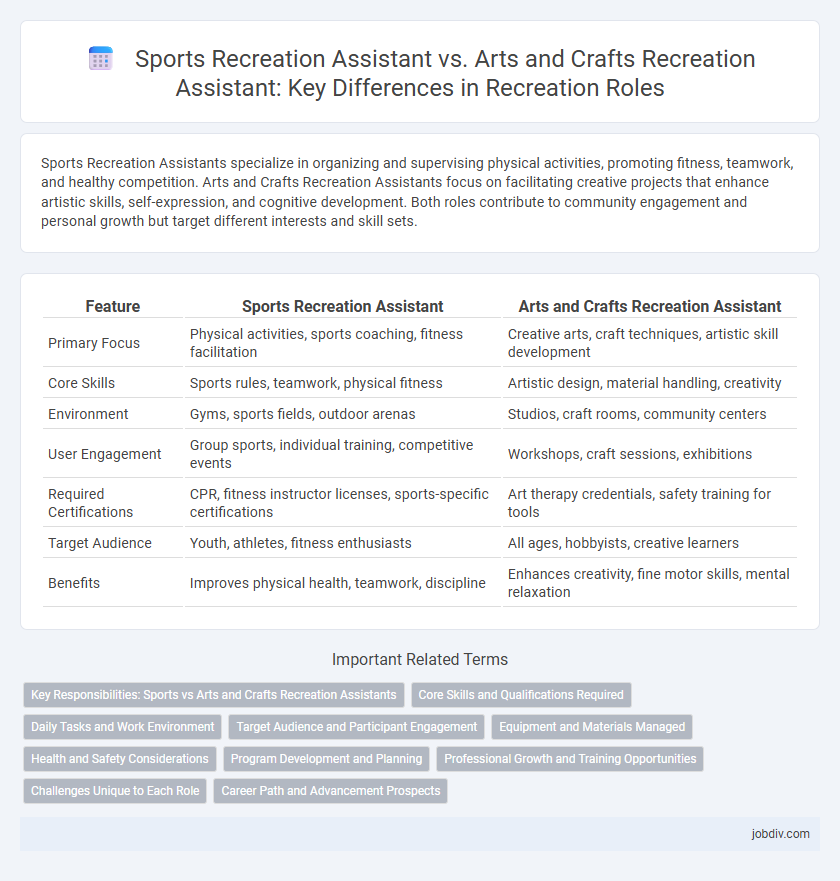Sports Recreation Assistants specialize in organizing and supervising physical activities, promoting fitness, teamwork, and healthy competition. Arts and Crafts Recreation Assistants focus on facilitating creative projects that enhance artistic skills, self-expression, and cognitive development. Both roles contribute to community engagement and personal growth but target different interests and skill sets.
Table of Comparison
| Feature | Sports Recreation Assistant | Arts and Crafts Recreation Assistant |
|---|---|---|
| Primary Focus | Physical activities, sports coaching, fitness facilitation | Creative arts, craft techniques, artistic skill development |
| Core Skills | Sports rules, teamwork, physical fitness | Artistic design, material handling, creativity |
| Environment | Gyms, sports fields, outdoor arenas | Studios, craft rooms, community centers |
| User Engagement | Group sports, individual training, competitive events | Workshops, craft sessions, exhibitions |
| Required Certifications | CPR, fitness instructor licenses, sports-specific certifications | Art therapy credentials, safety training for tools |
| Target Audience | Youth, athletes, fitness enthusiasts | All ages, hobbyists, creative learners |
| Benefits | Improves physical health, teamwork, discipline | Enhances creativity, fine motor skills, mental relaxation |
Key Responsibilities: Sports vs Arts and Crafts Recreation Assistants
Sports Recreation Assistants focus on organizing, leading, and supervising physical activities such as team sports, fitness programs, and outdoor games to promote physical health and teamwork. Arts and Crafts Recreation Assistants specialize in facilitating creative projects, providing materials, and guiding participants in painting, drawing, and crafting to foster artistic expression and fine motor skills. Both roles require strong interpersonal skills, but their key responsibilities differ in activity type, with Sports Assistants emphasizing physical engagement and Arts and Crafts Assistants prioritizing artistic development.
Core Skills and Qualifications Required
Sports Recreation Assistants require strong physical fitness, knowledge of sports rules, and the ability to organize and lead physical activities, along with certifications in first aid and CPR. Arts and Crafts Recreation Assistants need creativity, proficiency in various artistic techniques, and skills in instructing diverse age groups, often complemented by experience in event planning and art education. Both roles demand excellent communication, teamwork abilities, and a commitment to promoting inclusive and engaging recreational environments.
Daily Tasks and Work Environment
Sports Recreation Assistants organize and supervise athletic activities, ensuring participants follow safety protocols while promoting teamwork and physical fitness in gymnasiums, outdoor fields, or recreational centers. Arts and Crafts Recreation Assistants design and facilitate creative workshops, manage art supplies, and support individual self-expression within community centers, schools, or senior living facilities. Both roles require strong communication skills, with Sports Assistants focusing on physical engagement and safety, while Arts and Crafts Assistants emphasize creativity and therapeutic interaction in diverse indoor environments.
Target Audience and Participant Engagement
Sports Recreation Assistants primarily engage active participants seeking physical challenges and team-oriented activities, targeting youth, adults, and seniors interested in fitness and competitive play. Arts and Crafts Recreation Assistants attract creative individuals across all age groups who prefer hands-on projects, self-expression, and skill development through artistic mediums. Both roles require tailored engagement strategies, with sports assistants facilitating dynamic movement and teamwork, while arts and crafts assistants foster creativity and individual participation.
Equipment and Materials Managed
Sports Recreation Assistants manage equipment such as balls, nets, racquets, and protective gear essential for various physical activities, ensuring all items are safe, well-maintained, and ready for use. In contrast, Arts and Crafts Recreation Assistants handle materials like paints, brushes, clay, paper, and adhesives, maintaining inventory and preparing supplies to facilitate creative projects. Both roles require meticulous organization and upkeep of specialized resources tailored to their respective recreational activities.
Health and Safety Considerations
Sports Recreation Assistants prioritize rigorous health and safety protocols such as ensuring proper warm-up routines, monitoring hydration levels, and enforcing the use of protective gear to prevent injuries. Arts and Crafts Recreation Assistants focus on maintaining a safe environment by managing non-toxic materials, providing adequate ventilation, and preventing hazards like cuts from sharp tools or allergic reactions. Both roles require comprehensive risk assessments and emergency preparedness to promote a safe and enjoyable recreational experience.
Program Development and Planning
Sports Recreation Assistants specialize in program development by designing structured physical activities and competitive events that promote fitness and teamwork, incorporating sport-specific skills and safety protocols. Arts and Crafts Recreation Assistants focus on planning creative workshops and hands-on projects that encourage artistic expression and cognitive development, utilizing diverse materials and techniques to engage participants. Both roles require tailored program planning to meet the interests and abilities of diverse participant groups while ensuring resource efficiency and participant satisfaction.
Professional Growth and Training Opportunities
Sports Recreation Assistants gain professional growth through specialized training in physical fitness, coaching techniques, and injury prevention, enhancing their ability to manage athletic programs effectively. Arts and Crafts Recreation Assistants benefit from workshops in creative techniques, art therapy, and event organization, fostering skills in facilitating diverse artistic activities and community engagement. Both roles offer certifications and continuous learning opportunities tailored to their specific recreational focus, supporting career advancement and expertise development.
Challenges Unique to Each Role
Sports Recreation Assistants face challenges such as managing high-energy participants, ensuring safety during physical activities, and adapting programs for diverse skill levels and abilities. Arts and Crafts Recreation Assistants encounter difficulties in sourcing materials, stimulating creativity across different age groups, and accommodating varying artistic skill sets. Both roles require specialized communication skills to motivate and engage participants effectively while maintaining a positive recreational environment.
Career Path and Advancement Prospects
Sports Recreation Assistants typically advance by gaining certifications in coaching, fitness training, or sports management, leading to roles such as recreation coordinator or athletic director. Arts and Crafts Recreation Assistants often progress through developing specialized artistic skills or education credentials, enabling positions like program director or community arts manager. Both career paths offer growth through continued education and experience, but sports-focused roles may provide quicker advancement in competitive or organized sports settings.
Sports Recreation Assistant vs Arts and Crafts Recreation Assistant Infographic

 jobdiv.com
jobdiv.com